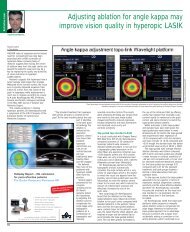ESCRS Guidelines on prevention, investigation and management of
ESCRS Guidelines on prevention, investigation and management of
ESCRS Guidelines on prevention, investigation and management of
You also want an ePaper? Increase the reach of your titles
YUMPU automatically turns print PDFs into web optimized ePapers that Google loves.
4. Investigati<strong>on</strong><br />
4.1 AC tap, vitreous tap, vitrectomy for Gram stain, culture <strong>and</strong> PCR tests<br />
The previous secti<strong>on</strong> describes diagnostic guidelines. A medical emergency exists as so<strong>on</strong> as the clinical<br />
diagnosis is made <strong>of</strong> acute bacterial endophthalmitis. There is a need to perform an anterior chamber tap <strong>and</strong> a<br />
vitreous tap within ONE hour <strong>of</strong> clinical diagnosis <strong>and</strong> to instil intravitreal antibiotics. The acute bacterial<br />
process is very 'unforgiving', giving rise to massive inflammati<strong>on</strong> within the posterior segment with a breakdown<br />
<strong>of</strong> the blood-ocular barrier. Hence, to save visi<strong>on</strong> there is need to stop the acute bacterial process but also to<br />
minimise the acute inflammati<strong>on</strong> that it has caused, hence the current opini<strong>on</strong> that unpreserved dexamethas<strong>on</strong>e<br />
400 µg in 0.1ml should be injected intravitreally at the same time as the antibiotics. The full arguments for <strong>and</strong><br />
against this approach, based <strong>on</strong> a scientific review, are c<strong>on</strong>sidered by Peyman, Lee & Seal [205].<br />
The questi<strong>on</strong> arises how to carry out the urgent taps <strong>and</strong> antibiotic instillati<strong>on</strong>. In some hospitals it is not<br />
possible to take the patient to the operating theatre (OT) at any given time because <strong>of</strong> use <strong>of</strong> the OT by others. It<br />
is not advisable to keep the patient waiting for more than three hours, because the chances <strong>of</strong> retaining<br />
reas<strong>on</strong>able visi<strong>on</strong> are diminishing fast. For this reas<strong>on</strong>, a portable vitrector has been developed by Peyman <strong>and</strong><br />
Visitec (Figure 5.1) to make an intravitreal tap within the outpatient clinic <strong>and</strong> to instil intravitreal antibiotics<br />
<strong>and</strong> dexamethas<strong>on</strong>e at the same time in the clinic (refer to surgical secti<strong>on</strong> below). Jager et al. [171] have found<br />
that it is safe to perform vitrectomy in the outpatient (OP) clinic providing that antiseptic prophylaxis is used<br />
with povid<strong>on</strong>e iodine; they found no statistical difference in acquired endophthalmitis rates after vitrectomy<br />
between the two sites – OT <strong>and</strong> OP (refer to incidence secti<strong>on</strong> above).<br />
Use <strong>of</strong> the phaco/vitrector equipment, for a partial or full vitrectomy, is c<strong>on</strong>sidered below in the treatment<br />
(surgical) secti<strong>on</strong>. It can be used for both sample collecti<strong>on</strong> <strong>and</strong> a full vitrectomy.<br />
Antibiotics (refer below) are instilled with separate syringes <strong>and</strong> 25 or 30 G needles for each drug, either<br />
injecting directly through the pars plana or by injecting through the sclerotomy wound if present. The scleral<br />
wound is usually self-sealing <strong>and</strong> does not need to be sutured.<br />
Identificati<strong>on</strong> <strong>of</strong> the pathogen in infectious endophthalmitis is rati<strong>on</strong>al as this allows targeted antibiotic therapy.<br />
The sampling should be d<strong>on</strong>e as so<strong>on</strong> as possible, <strong>and</strong> within ONE hour, after the diagnosis is made. Enlist the<br />
help <strong>of</strong> the microbiologist.<br />
Microscopy <strong>and</strong> Gram stain results are available after <strong>on</strong>e hour, pathogen culture results after 24 h, <strong>and</strong><br />
antibiotic sensitivity testing results after six to 10 hours when the RAST method is used, or after 24 to 48 h<br />
with c<strong>on</strong>venti<strong>on</strong>al methods [103].<br />
The highest rate <strong>of</strong> pathogen identificati<strong>on</strong> is obtained with microscopic <strong>and</strong> microbiological processing <strong>of</strong><br />
vitreous material, obtained either using the vitrectomy cutter before switching <strong>on</strong> the irrigati<strong>on</strong> or as an aspirate,<br />
or using the portable vitrector. Use <strong>of</strong> a syringe <strong>and</strong> needle gives an unreliable sample that is <strong>of</strong>ten dry <strong>and</strong><br />
culture-negative.<br />
Pathogen identificati<strong>on</strong> from the anterior chamber is less successful <strong>and</strong> also potentially c<strong>on</strong>taminated by the<br />
vitrectomy cassette [20], [101]. C<strong>on</strong>junctival <strong>and</strong> corneal swabs are pointless, as the correlati<strong>on</strong> with the microorganisms<br />
isolated is too low [42]. The culture media should be inoculated directly in the operating theatre<br />
[189]. Transportati<strong>on</strong> <strong>of</strong> material <strong>on</strong> cott<strong>on</strong> buds produces a high loss <strong>of</strong> pathogens <strong>and</strong> reduces the detecti<strong>on</strong><br />
rate, which ideally is about 90 per cent [102].<br />
The polymerase chain reacti<strong>on</strong> (PCR) method <strong>of</strong>fers much improved pathogen detecti<strong>on</strong> especially in the case <strong>of</strong><br />
chr<strong>on</strong>ic endophthalmitis with low pathogen counts [34], [205]. However, the increased risk <strong>of</strong> c<strong>on</strong>taminati<strong>on</strong><br />
because <strong>of</strong> the high sensitivity <strong>of</strong> the method, the lack <strong>of</strong> antibiotic sensitivity testing <strong>and</strong> the partial lack <strong>of</strong><br />
quality c<strong>on</strong>trol st<strong>and</strong>ards in routine diagnostic laboratories have limited its routine use so far. PCR has been<br />
evaluated in depth in the multi-centre <str<strong>on</strong>g>ESCRS</str<strong>on</strong>g> study by the two expert laboratories menti<strong>on</strong>ed above. Results <strong>of</strong><br />
this cross-validati<strong>on</strong> study are not yet published [11].<br />
4.2 Epidemiology<br />
For detailed discussi<strong>on</strong> <strong>on</strong> how to investigate an outbreak <strong>of</strong> cataract-surgery-associated post-operative<br />
endophthalmitis, the reader is referred to Chapter 4 <strong>of</strong> Peyman, Lee & Seal's book [205]. This chapter<br />
c<strong>on</strong>siders the epidemiology <strong>of</strong> post-operative endophthalmitis in detail <strong>and</strong> has tables from which actual<br />
numbers <strong>of</strong> cases <strong>of</strong> endophthalmitis can be compared with predicted numbers for different incidence rates<br />
<strong>of</strong> infecti<strong>on</strong>, <strong>and</strong> thus determine whether the number <strong>of</strong> cases is greater-than-expected statistically, requiring<br />
the unit to close for detailed investigati<strong>on</strong>s. One <strong>of</strong> the most important aspects to then determine is whether<br />
there is a comm<strong>on</strong> source outbreak or whether it is due to a selecti<strong>on</strong> <strong>of</strong> different types <strong>of</strong> bacteria out <strong>of</strong><br />
those normally found <strong>on</strong> the lid margin or in the c<strong>on</strong>junctival sac [214]. The former is <strong>of</strong>ten associated with<br />
a staff carrier for Staphylococcus aureus or Pseudom<strong>on</strong>as aeruginosa if c<strong>on</strong>taminated soluti<strong>on</strong>s are involved,<br />
while the latter is more <strong>of</strong>ten associated with failures <strong>of</strong> either washing the instruments or with their<br />
sterilisati<strong>on</strong> or with a failure <strong>of</strong> the air c<strong>on</strong>diti<strong>on</strong>ing system in summer, causing the surge<strong>on</strong>s to shed<br />
excessive numbers <strong>of</strong> bacteria. It may be necessary to introduce an intra-cameral injecti<strong>on</strong> <strong>of</strong> antibiotic when<br />
the unit reopens if the source cannot be found.<br />
19





